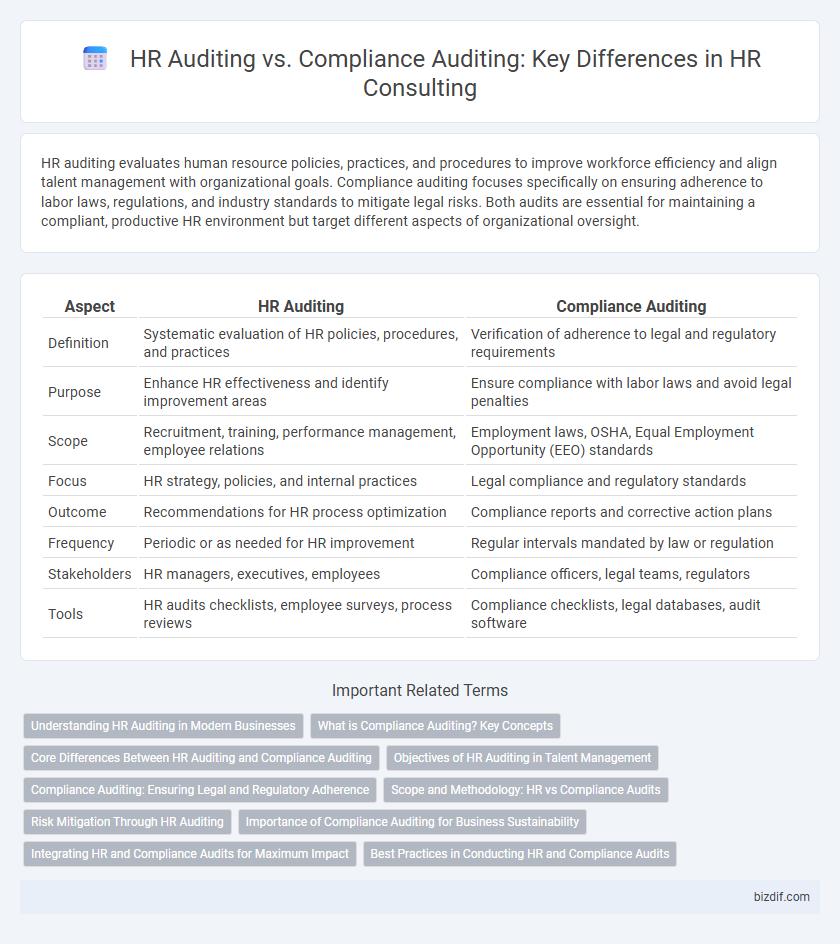HR auditing evaluates human resource policies, practices, and procedures to improve workforce efficiency and align talent management with organizational goals. Compliance auditing focuses specifically on ensuring adherence to labor laws, regulations, and industry standards to mitigate legal risks. Both audits are essential for maintaining a compliant, productive HR environment but target different aspects of organizational oversight.
Table of Comparison
| Aspect | HR Auditing | Compliance Auditing |
|---|---|---|
| Definition | Systematic evaluation of HR policies, procedures, and practices | Verification of adherence to legal and regulatory requirements |
| Purpose | Enhance HR effectiveness and identify improvement areas | Ensure compliance with labor laws and avoid legal penalties |
| Scope | Recruitment, training, performance management, employee relations | Employment laws, OSHA, Equal Employment Opportunity (EEO) standards |
| Focus | HR strategy, policies, and internal practices | Legal compliance and regulatory standards |
| Outcome | Recommendations for HR process optimization | Compliance reports and corrective action plans |
| Frequency | Periodic or as needed for HR improvement | Regular intervals mandated by law or regulation |
| Stakeholders | HR managers, executives, employees | Compliance officers, legal teams, regulators |
| Tools | HR audits checklists, employee surveys, process reviews | Compliance checklists, legal databases, audit software |
Understanding HR Auditing in Modern Businesses
HR auditing in modern businesses systematically evaluates human resource policies, practices, and procedures to ensure alignment with organizational goals and legal requirements. It identifies gaps in talent management, employee engagement, and workforce planning, enabling companies to optimize HR functions for improved productivity and risk mitigation. This process differs from compliance auditing, which primarily focuses on adherence to regulatory standards and legal frameworks.
What is Compliance Auditing? Key Concepts
Compliance auditing in HR focuses on evaluating an organization's adherence to legal regulations, industry standards, and internal policies related to employment practices. Key concepts include verifying conformity with labor laws, health and safety regulations, anti-discrimination statutes, and data privacy requirements. This type of audit ensures that HR operations minimize legal risks and promote ethical workforce management.
Core Differences Between HR Auditing and Compliance Auditing
HR auditing evaluates the effectiveness of human resource policies, practices, and processes to align with organizational goals and improve workforce management. Compliance auditing specifically verifies adherence to labor laws, regulations, and internal policies to avoid legal risks and penalties. Core differences include HR auditing's broader scope on strategic HR functions versus compliance auditing's focus on regulatory conformity and risk mitigation.
Objectives of HR Auditing in Talent Management
HR auditing in talent management aims to evaluate the effectiveness of recruitment, employee development, and retention strategies to ensure alignment with organizational goals. It identifies skill gaps, optimizes workforce planning, and enhances employee engagement by assessing training programs and performance management systems. This audit helps organizations maintain a competitive advantage through strategic talent acquisition and development while ensuring legal compliance.
Compliance Auditing: Ensuring Legal and Regulatory Adherence
Compliance auditing in HR focuses on systematically evaluating an organization's adherence to employment laws, industry regulations, and internal policies to mitigate legal risks. This process involves verifying documentation, monitoring practices related to wage laws, workplace safety, anti-discrimination statutes, and employee benefits compliance. Ensuring thorough compliance auditing helps companies avoid penalties, safeguard their reputation, and maintain ethical standards in workforce management.
Scope and Methodology: HR vs Compliance Audits
HR auditing evaluates organizational human resource policies, processes, and employee relations to ensure alignment with strategic goals and workforce effectiveness. Compliance auditing focuses on verifying adherence to legal regulations and industry standards by examining documentation, procedures, and risk controls related to labor laws and workplace safety. The methodology for HR audits involves qualitative assessments and employee feedback, while compliance audits rely heavily on quantitative data analysis and regulatory checklists.
Risk Mitigation Through HR Auditing
HR auditing systematically evaluates human resource policies, procedures, and practices to identify potential legal, financial, and operational risks, ensuring alignment with organizational goals. Unlike compliance auditing, which primarily verifies adherence to laws and regulations, HR auditing proactively uncovers gaps and vulnerabilities that could lead to employee disputes, regulatory penalties, or reputational damage. Implementing HR audits strengthens risk mitigation by enabling early detection and corrective action on issues related to hiring, compensation, workplace safety, and employee relations.
Importance of Compliance Auditing for Business Sustainability
Compliance auditing ensures that a business adheres to labor laws, industry standards, and internal policies, mitigating risk and avoiding costly legal penalties. It provides a systematic review of regulatory obligations, promoting transparency and accountability critical for long-term operational stability. Regular compliance audits support sustainable growth by identifying gaps and enabling proactive adjustments in HR practices.
Integrating HR and Compliance Audits for Maximum Impact
Integrating HR auditing with compliance auditing enhances organizational effectiveness by identifying gaps in policies, employment practices, and regulatory adherence simultaneously. This combined approach streamlines risk management and ensures comprehensive evaluation of labor laws, workplace safety, and company-specific HR standards. Leveraging data analytics in integrated audits provides actionable insights that drive strategic improvements, promoting legal compliance and workforce optimization.
Best Practices in Conducting HR and Compliance Audits
Best practices in conducting HR and compliance audits include thorough documentation review, employee interviews, and proactive risk assessments to identify gaps in policies and procedures. HR auditing emphasizes workforce management, employee relations, and talent development metrics, while compliance auditing focuses on regulatory adherence and legal requirements. Leveraging technology for data analysis and maintaining clear communication with stakeholders enhances audit accuracy and effectiveness.
HR Auditing vs Compliance Auditing Infographic

 bizdif.com
bizdif.com